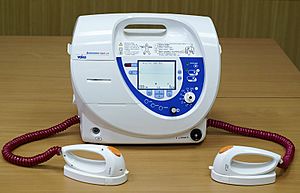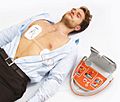Defibrillation facts for kids
Defibrillation is a special medical treatment. It helps the heart when it's not pumping blood correctly. This happens when the heart muscle isn't working in a steady, organized way.
Our bodies use electricity to make muscles move. This is how our nerves tell muscles what to do. The heart is a big muscle. Different parts of it need to squeeze in a certain order. This makes sure blood is pushed through the heart and out to the rest of the body.
Sometimes, the heart muscle doesn't squeeze the right way. It might beat too fast, too slow, or just quiver. This is called an arrhythmia, which means "out of rhythm." A serious type of arrhythmia is called fibrillation. In fibrillation, the whole heart just quivers. It doesn't pump any blood.
When the heart is fibrillating, CPR can help. CPR pushes blood around the body. But the heart still needs to get back to its normal rhythm. Sometimes CPR can help restart the heart. Often, a special device called a defibrillator is needed. Defibrillation is the treatment done with this device.
Defibrillation works by sending a strong electric current to the heart. This "resets" the heart's electrical activity. The goal is to help the heart return to a normal, organized rhythm. The electric shock removes the existing electrical charge from a large part of the heart muscle. This stops the bad rhythm and allows the heart's natural pacemaker to take over.
Defibrillators can be used outside the body. These are called external defibrillators or automated external defibrillators (AEDs). Some defibrillators are placed inside the body. These are called implantable cardioverter-defibrillators (ICDs).
Contents
How Defibrillation Started
The first time defibrillation was used on a human was in 1947. A doctor named Claude Beck did it. He was a professor of surgery. His patient was a 14-year-old boy.
Today, defibrillation is also used during open heart surgery. Sometimes, doctors stop the heart on purpose during these operations. In 1980, the first implanted defibrillator was put into a patient. These implanted devices are placed in people's chests. They help those who are at risk of their heart going into fibrillation.
Understanding Heart Rhythms
Not all heart rhythm problems (arrhythmias) need defibrillation. Some arrhythmias still allow blood to be pumped. It might not be perfect, but it's enough to keep a person alive.
However, some types of arrhythmias are very dangerous. These include ventricular fibrillation or pulseless ventricular tachycardia. If not treated quickly, a person can die within minutes. These are the types that need defibrillation.
- Fibrillation is when the heart muscle squeezes, but not in an organized way. No blood is pumped.
- Pulseless tachycardia is when the heart beats too fast. It beats so fast that it doesn't have time to fill with blood to push out.
When the heart is not working at all, it's called asystole (a "flat-line" on a heart monitor). Defibrillation does not work for asystole. But CPR can still be helpful in these cases.
Chances of Success
Defibrillation works best when it's done very soon after the problem starts. If done in the first minute, the chance of success is about 90%. This chance drops by 10% every minute after that. Giving the person CPR can help extend this time. But having a defibrillator nearby is very important for the best outcome.
Related pages
Images for kids
See also
 In Spanish: Desfibrilación y cardioversión eléctrica para niños
In Spanish: Desfibrilación y cardioversión eléctrica para niños






